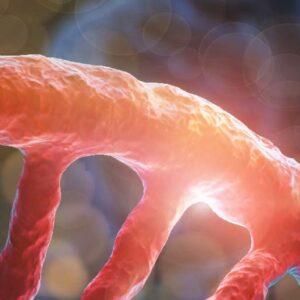Thoracic aortic aneurysms and dissections (TAAD) affecting the ascending aorta directly behind the aortic valve (type A dissection) or the descending aorta in the left subclavian artery distal to the aortic arch (type B dissection), may occur due to a genetically determined syndrome or in isolation. About 10-20% are inherited in an autosomal dominant manner with reduced penetrance and variable expression. TAAD are clinically and genetically heterogeneous.
Syndromic aortic diseases include:
- Marfan syndrome (MFS; FBN1 gene)
- Loeys-Dietz syndrome type 1 (LDS1; TGFBR1 gene)
- Loeys-Dietz syndrome type 2 (LDS2; TGFBR2 gene)
- Loeys-Dietz syndrome type 3 (LDS3; SMAD3 gene)
- Loeys-Dietz syndrome type 4 (LDS4; TGFB2 gene)
- Loeys-Dietz syndrome type 5 (LDS5; TGFB3 gene)
- Loeys-Dietz syndrome type 6 (LDS6; TGFB2 gene)
- Meester-Loeys syndrome (MRLS; BGN gene)
- Ehlers-Danlos syndrome, vascular type (vEDS;COL3A1 gene)
- Ehlers-Danlos syndrome with periventricular heterotopia (EDS, PVNH4; FLNA gene)
- Ehlers-Danlos syndrome, classic type (cEDS; COL5A1 gene, COL5A2 gene, COL1A1 gene)
- Ehlers-Danlos syndrome, kyphoscoliotic type (kEDS; PLOD1 gene)
- Rare syndromes with risk for TAAD: arterial tortuosity syndrome (ATS; SLC2A10 gene), autosomal dominant and autosomal recessive cutis laxa (ADCL1, ADCL2, ARCL1A, ARCL1B, ARCL1C; ELN, FBLN5, EFEMP2, LTBP4)
In addition, there are other connective tissue diseases with a risk of aortic aneurysms and dissections in other. For isolated familial TAAD, linkage analyses have so far localized 11 gene loci and identified nine genes:
- AAT3 on chromosome 3p24-25 (TGFBR2 gene)
- AAT4 on chromosome 16p13.13-p13.12 (MYH11 gene)
- AAT5 on chromosome 9q33-q34 (TGFBR1 gene)
- AAT6 on chromosome 10q22-24 (ACTA2 gene)
- AAT7 on chromosome 3q21 (MYLK gene)
- AAT8 on chromosome 10q11.2-q21.1 (PRKG1 gene)
- AAT9 on chromosome 12p13.31 (MFAP5 gene)
- AAT10 on chromosome 5q23.1 (LOX gene)
- AAT11 on chromosome 1p33 (FOXE3 gene)
No gene has yet been identifed for AAT1 on chromosome 11q23-24 and AAT2 on chromosome 5q13-14. Further genes with pathogenic variants in TAAD are MAT2A and SMAD2, as well as GATA5, NOTCH1, ROBO4 and SMAD6, whereby changes in the latter four cause bicuspid aortic valves.
Since the clinical differential diagnosis of aortic diseases is often difficult, genetic diagnostics using NGS is one way of finding the cause.
References
Renard et al. 2018, J Am Coll Cardiol 72:605 / Milewicz and Regalado In: Adam MP, Ardinger HH, Pagon RA, et al, eds. GeneReviews® (Updated 2017 Dec 14) / Arslan-Kirchner et al. 2016, Eur J Hum Genet 24 / Bowdin et al. 2016, Canadian J Cardiol 32:131 / Zhang and Wang 2016, Clin Genet 89:639 / Guo et al. 2013, Am J Hum Genet 93:398 / Boileau et al. 2012, Nat Genet 44:916 / van de Laar et al. 2011, Nat Genet 43:121 / Wang et al. 2010, Am J Hum Genet 87:701 / Guo et al. 2007, Nat Genet 39:1488 / Zhu et al. 2006, Nat Genet 38:343 / Pannu et al. 2005, Circulation 112:513 / Dietz et al. 2005, Am J Med Genet 139C:4





















